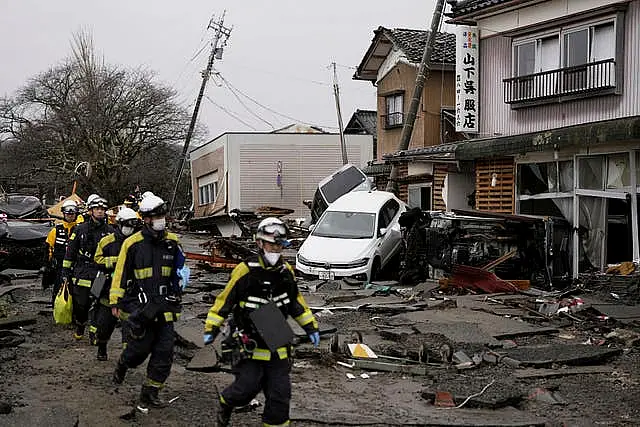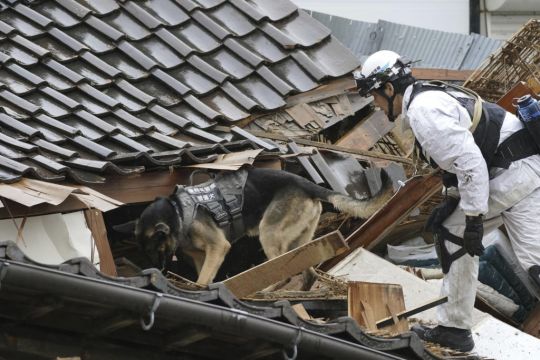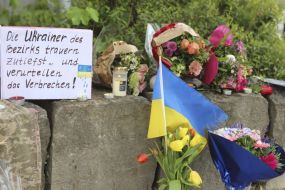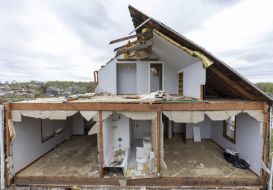Rescue workers and dog units were urgently sifting through rubble on Wednesday ahead of predicted freezing cold and heavy rain in what the prime minister called a race against time after powerful earthquakes killed 73 people in western Japan.
Dozens are believed to be trapped under collapsed buildings.
Ishikawa prefecture and nearby areas were rattled by a 4.9 magnitude aftershock early on Wednesday – one of scores that have followed Monday’s shallow magnitude 7.6 quake with an epicentre at Noto, about 185 miles (300km) from Tokyo on the opposite coast.
The shaking set off tsunami warnings, followed by waves more than 3ft (1m) high in some places.
The first 72 hours are especially critical, experts say, because the prospects for survival greatly diminish after three days.
Prime Minister Fumio Kishida told reporters: “More than 40 hours have passed. This is a race against time, and I feel that we are at a critical moment. We have received reports many people are still waiting for rescue under collapsed buildings.”
Noto’s narrow peninsula landscape has added to the challenges in reaching some communities, and water, power and mobile phone service are still down in some areas.
“Hardly any of the homes are standing. They are either partially or totally destroyed,” said Masuhiro Izumiya, mayor of neighbouring Suzu city, which suffered heavy damage.

Relief officials handed out water, blankets, food and other supplies, while search dogs joined military personnel and firefighters trying to find and rescue dozens of people who are thought to be trapped, although the exact number is unclear.
Weather forecasts warned of heavy rain in Ishikawa, leading to fears of landslides and further damage to half-crumbled homes. Temperatures were expected to drop to around 4C (39F) overnight.
Of the deaths, 39 were counted in Wajima city, while 23 people died in Suzu, according to Ishikawa prefectural authorities. The other deaths were reported in five neighbouring towns.
Kyodo News said the death toll had risen to 73 because of more fatalities in Wajima.
More than 300 people have been injured, at least 25 of them seriously.
Ishikawa Governor Hiroshi Hase encouraged everyone to use masks, antiseptic and soap to guard against the spread of infectious diseases as evacuees sheltered together. Ensuring adequate water supplies and bathroom services for those who were displaced is a priority, he said.

People on the coastline are already picking up the pieces, like Noto resident Kazuyuki Iwaike, who was deep in thought as he cleaned up his home. It was sheer chance that he avoided death because he was not at home when the tsunami that followed the earthquakes struck.
“I always thought it was someone else’s problem, thinking there is no way a tsunami would come,” he said.
Officials warned that things are unpredictable and it is possible that even bigger earthquakes could hit.
In the aftermath of the quakes and tsunami, boats lay overturned in water, roads were blocked by mounds of dirt, and shovels scooped scattered pillars and walls from flattened homes. A large fire turned an entire section of Wajima city into ashes.
As a quake-prone nation with criss-crossing fault lines and many volcanoes, Japan has had its share of disasters, including a quake, tsunami and nuclear disaster in north-eastern Japan in 2011.
Several nuclear plants in the region raised concern, although no major problems or rise in radiation levels have been reported. Shika nuclear plant in Ishikawa suffered partial electricity failure, but back-up power kicked in, ensuring the critical cooling process continued.

Japan is an organised, conformist and relatively crime-free society, where warnings are systematically relayed as a public service. Disaster experts say that is helping to save lives.
The Japan Meteorological Agency lifted tsunami warnings on Tuesday.
Australian Prime Minister Anthony Albanese joined US President Joe Biden and other world leaders in expressing sympathy for the Japanese.
“Our hearts go out to our friends in Japan,” Mr Albanese said. “We will provide, and have offered, whatever support is requested by our friends in Japan.”
Takako Izumi, a disaster science professor at Tohoku University, said time is needed to figure out logistics because roads are often blocked after an earthquake, and large trucks cannot get through to deliver aid.
If land routes are not accessible, aid may have to be dropped from the sky or brought in by boat. The winter cold adds to health risks, and some people may still have not reached an evacuation centre, she added.
“We need to accurately assess the damage first. And then a proper response can come, and what’s needed can reach the right places.”







